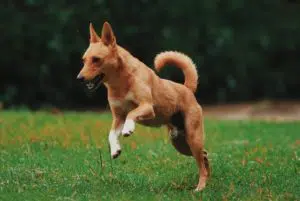
Many anxious dogs may bark, lunge and even go to bite when feeling threatened by strangers or other dogs that get too close to them, this is known as fear-based aggression. I have this with my rescue dog Vindi, which is why I am so passionate about educating people about responsible dog interactions.
Then there are those dogs that are submissive or back away when approached, clearly demonstrating they are feeling uncomfortable.
So, I wanted to talk about what responsible dog interactions look like, where it tends to go wrong, and what people should do instead.
Firstly, you need to know what anxiety signs to look out for in your own and other dogs that indicate they are not comfortable and want some space.
These include the subtle signs like yawning out of context, flicking of their tongue and licking their lips, panting, ducking their head, ears back, averting eye contact and tail tucked under.
Then there’s the obvious ones like cowering, backing away, perhaps submissively rolling over, or the fear-based responses like growling, barking or lunging at people or other dogs.
In all of these instances above it’s so important you don’t keep approaching the dog, and definitely don’t put your hand out to them, despite what you’ve been told!
As the owner of an anxious dog and as a trainer, I can assure you that having someone shove a hand into their space is the last thing they want and can often result in a snap if an owner is not quick enough to stop this kind of approach.
Responsible dog interactions would instead see you simply move away, avoid eye contact with the dog (an understanding smile to the owner would be a nice touch) and give them the space they need.
If you aren’t sure and neither is the owner, learn how to approach a dog HERE.
If your own puppy or dog is off lead, please don’t let them run up to other dogs unless you are absolutely sure the dog is comfortable with that.
Anyone working on their dog’s anxiety or reactivity needs to keep them from reacting in the first place, as part of the behaviour modification training, so this is important for both the anxious dog and for your own dog’s safety.
If you can’t stop your own dog from running straight up to others uninvited then you may need to work on your own dog’s impulse control and recall.
On that note, I do recommend that owners of anxious or reactive dogs don’t take them to off-leash dog parks, it can make their anxiety worse, so get the help of a qualified trainer to work on it with you in the right environment.
If you see an owner with their dog at a distance that suddenly stops when they see you, or is looking to cross the road and create some distance, or perhaps they are already struggling with a growling or lunging dog, the best thing you can do is just stop your approach until they can get their dog out of the situation. Distance from the perceived ‘threat’ is what that dog needs most, and before they have felt the need to react. This is critical to their training.
I can’t tell you how wonderful it feels when another dog owner stops and acknowledges what’s going on with an understanding smile and a knowing nod.
There are a lot of rescue dogs in new homes and many owners struggling with this issue, so rather than continuing your approach or casting judgement when you see a dog acting a little like a child having a tantrum, remember a little bit of empathy goes a long way.
Finally, if you find it too hard to walk past a dog without saying hi, and they aren’t displaying any signs of anxiety, always make sure you give them control of the situation when it comes to responsible dog interactions.
Turn to your side, pat your leg and see if they want to come to you. If they don’t approach, or move away, leave them alone.
If they do come over, don’t lean in over the top of them come, slowly come in from the front or underneath their face and give them a tickle on the chin.
We all have our bad days…and so can dogs, so always keep an eye on their body language and what your own or other dogs are saying to you with their body language.
If you do have an anxious dog, talk to your local PETstock Vet or puppy school. Some areas also offer mobile dog training services which may also help.
Medication may also be required to help you with your behaviour modification training, as a stress or anxious dog is unable to take in new information, so it can help with the process.
Positive reinforcement training is the only option too when training an anxious dog, to avoid making the problem worse.
About the Author: Lara Shannon is a certified dog behaviourist and trainer, Executive Producer and Host of Pooches at Play on Channel 10 and editor of Poochesatplay.com. Lara runs her own dog training business in Melbourne’s Bayside area, is a sought after pet expert speaker and Author of Eat, Play, Love (Your Dog).

Exercising puppies – how much do they need?


Toilet Training a Puppy for success

Tips for training a reactive dog



Get your paws on Lara Shannon’s best selling books ‘Eat, Play, Love (your dog) and World of Dogs.
Available in Australia, USA, UK and Canada.